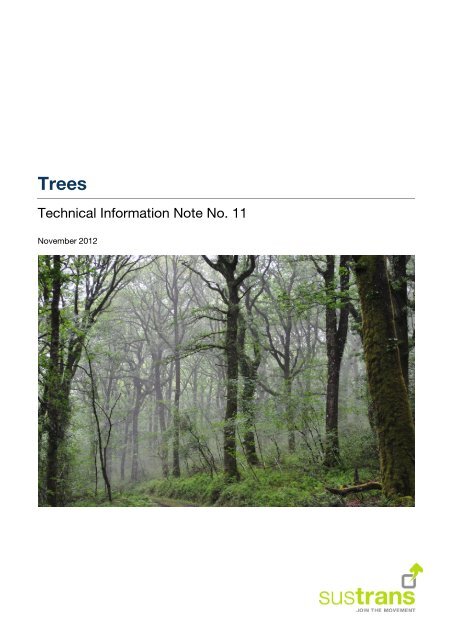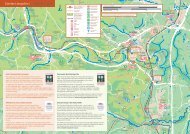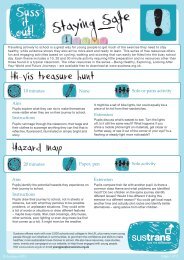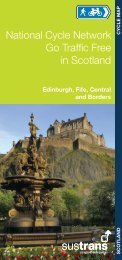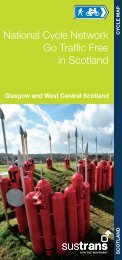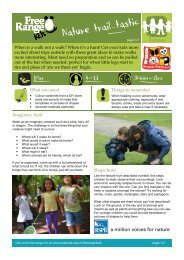Technical Note 11 - Trees - Sustrans
Technical Note 11 - Trees - Sustrans
Technical Note 11 - Trees - Sustrans
You also want an ePaper? Increase the reach of your titles
YUMPU automatically turns print PDFs into web optimized ePapers that Google loves.
<strong>Trees</strong><br />
<strong>Technical</strong> Information <strong>Note</strong> No. <strong>11</strong><br />
November 2012
About <strong>Sustrans</strong><br />
<strong>Sustrans</strong> makes smarter travel choices possible, desirable and inevitable. We’re a leading UK charity<br />
enabling people to travel by foot, bike or public transport for more of the journeys we make every<br />
day. We work with families, communities, policy-makers and partner organisations so that people<br />
are able to choose healthier, cleaner and cheaper journeys, with better places and spaces to move<br />
through and live in.<br />
It’s time we all began making smarter travel choices. Make your move and support <strong>Sustrans</strong> today.<br />
www.sustrans.org.uk<br />
Head Office<br />
<strong>Sustrans</strong><br />
2 Cathedral Square<br />
College Green<br />
Bristol<br />
BS1 5DD<br />
© <strong>Sustrans</strong> November 2012<br />
Registered Charity No. 326550 (England and Wales) SC039263 (Scotland)<br />
VAT Registration No. 416740656<br />
Issue level: 02<br />
Owned by: NCN Director<br />
Contact: Hannah.lewisl@sustrans.org.uk<br />
All photos by <strong>Sustrans</strong> unless noted otherwise<br />
1 <strong>Trees</strong> <strong>Technical</strong> Information <strong>Note</strong> No. <strong>11</strong> November 2012
Introduction<br />
<strong>Sustrans</strong> and Railway Paths Ltd (RPL) manage land throughout the UK. <strong>Trees</strong> and woodlands are<br />
present on much of this land and whilst they are often highly valued features, they can be a source of<br />
maintenance issues. This <strong>Technical</strong> Information <strong>Note</strong> discusses <strong>Sustrans</strong> responsibilities as tree<br />
owners and our policies for dealing with trees and woodlands in relation to new construction, path<br />
repairs, complaints from neighbours and maintaining structures.<br />
There are also several pieces of legislation that need to be taken into account before conducting tree<br />
work. This TIN describes Felling Licences, Tree Protection Orders, Built Conservation Areas and<br />
Wildlife Legislation. Tree inspections, to identify potentially hazardous trees, are detailed in<br />
H&S/STD/15: <strong>Sustrans</strong> Tree and Woodland Inspection Standard.<br />
<strong>Sustrans</strong> responsibilities as tree owners<br />
<strong>Sustrans</strong> and Railway Paths Ltd. have a responsibility to ensure that trees on our land do not<br />
threaten the safety of people using our land and that they do not damage neighbours properties or<br />
our own structures and bridges.<br />
<strong>Trees</strong> are living organisms that will shed branches and eventually fall. The risk to people is extremely<br />
low, and the aesthetic and ecological value of trees is high. We usually aim to retain trees outside<br />
the immediate path corridor but have a legal duty of care to make sure our land is reasonably safe.<br />
As such <strong>Sustrans</strong> has a formalised tree inspection process to identify any obviously hazardous trees<br />
and reduce the risk appropriately. H&S/STD/15: <strong>Sustrans</strong> Tree and Woodland Inspection Standard<br />
details the inspection process and alternative methods of reducing the risk. If any rapid deterioration<br />
in tree health is noted, the person responsible for tree inspections should be informed. This<br />
<strong>Technical</strong> Information <strong>Note</strong> details our policies and legal considerations for conducting tree works.<br />
It is very important not to lump all trees into one bracket or subject. The diversity is extensive. A<br />
considerable quantity of trees on disused railways, especially from track-bed and in cuttings is<br />
naturally regenerated scrub woodland of even age structure, of high density and high resilience. In a<br />
world apart are mature & landscape trees, of wide age structure, of low density, whether planted or<br />
naturally regenerated, which need to be treated as much more valuable and often less resilient.<br />
In order to prevent damage occurring to our own structures, and to allow them to be inspected for<br />
damage or faults, vegetation must be managed around those structures. Where trees cause<br />
foreseeable damage to neighbouring property (e.g. roots threaten to topple walls etc), then the<br />
owner of the tree (i.e. the landowner where the tree trunk grows) must take action to prevent this<br />
damage. If a tree grows exactly on a boundary, then it is shared property and both parties have<br />
equal rights and responsibilities<br />
Under common law a landowner can cut the branches from a neighbour's trees if they overhang his<br />
or her property. The same rule applies to encroaching roots, although should harm occur as a result<br />
of this pruning, liability may follow. The cut branches, including any fruit, remain the property of the<br />
neighbouring owner, however the owner cannot be forced to deal with them.<br />
The felling of trees is controlled via the need for Felling Licences, the designation of Tree<br />
Preservation Orders and Built Conservation Areas and can also be restricted by legislation regarding<br />
wildlife protection. These are all discussed in relevant sections below.<br />
Some trees on our land are placed deliberately and form part of the “path design”, i.e. they break up<br />
long straight sightlines or are a particular feature of the path. Many of our trees are planted or<br />
maintained to encourage wildlife. Such trees should be managed so that they continue to provide<br />
their function, and should be protected from being cut down. However if they are now causing<br />
2 <strong>Trees</strong> <strong>Technical</strong> Information <strong>Note</strong> No. <strong>11</strong> November 2012
problems or making the route feel more enclosed, then their removal or heavy thinning should be<br />
properly considered. <strong>Trees</strong> are not necessarily planted as fixtures, and often their growth rate and<br />
final size is grossly underestimated at time of early works.<br />
<strong>Trees</strong> and neighbours<br />
For some time it has been <strong>Sustrans</strong>’ land management policy that we will to do work at our cost on<br />
trees that are dangerous, diseased or causing structural problems. All trees are regularly inspected<br />
by <strong>Sustrans</strong> staff in line with the <strong>Sustrans</strong> Tree Inspection Standard but the condition of trees can<br />
change suddenly and rapidly and complaints from the public can help bring this to our attention.<br />
<strong>Sustrans</strong> will not necessarily conduct work on healthy trees that are just blocking light or for other<br />
non-essential reasons. There is no legal right to light and trees are often a valued feature of our<br />
routes. In some cases we do suggest that we would be perfectly happy to allow the neighbour to<br />
commission a professional tree surgeon to do work at their expense provided that we see and<br />
approve their proposals, including detailed method statements prior to work being undertaken.<br />
If this work requires entering <strong>Sustrans</strong> or RPL land then the neighbour should get written permission<br />
from us to do so. We should agree a safe access route with the neighbour through our land and<br />
inform her / him of any dangers such as overhead wires. In any case we should confirm to her / him<br />
that we take no responsibility for the health and safety of the tree surgeon while working on our land,<br />
that they must ensure the welfare of people using our path and that all ecological legislation is<br />
observed. There is a Health and Safety standard available covering management of work on our land<br />
by neighbours (H&S/STD/13: Work by Others).<br />
<strong>Trees</strong> by structures and buildings<br />
<strong>Sustrans</strong> and Railway Paths Ltd are responsible for maintaining more than <strong>11</strong>00 structures such as<br />
bridges, tunnels and retaining walls. Many buildings, in particular houses, are situated in close<br />
proximity to our land. <strong>Trees</strong> growing on, or very close to structures or buildings can damage the<br />
structure directly as their roots or branches grow or by impact if they fall onto any part of the<br />
structure. They also obscure other cracks and faults that need to be monitored by the Bridge<br />
Engineer. As such it is important that we keep the structures clear of vegetation, including trees.<br />
It is <strong>Sustrans</strong> policy to keep an area, 3m from all elements of the structure, clear of any vegetation.<br />
Saplings and young trees growing from within 5m of any structure or building should be removed to<br />
prevent future problems. The removal of semi mature and mature trees growing from between 3m<br />
and 5m of the structure should also be considered, particularly if there is existing evidence of<br />
damage to the structure. <strong>Trees</strong> that are removed should be cut low down on the trunk and the<br />
stump and roots should remain. A suitable treatment, such as Ecoplugs, should be applied to the<br />
stump to prevent any re-growth.<br />
The tree inspections undertaken in line with in H&S/STD/15: <strong>Sustrans</strong> Tree and Woodland<br />
Inspection Standard should also inspect the trees in close proximity to the structure to determine<br />
whether they are likely to fall, drop limbs or grow in a direction that might damage the structure. If<br />
any rapid deterioration in tree health is noted, the person responsible for tree inspections should be<br />
informed.<br />
New construction around trees<br />
Generally, new paths should be routed around the root zones of existing trees where possible.<br />
Where a tree preservation order exists or in Built Conservation Area retaining the tree is mandatory<br />
unless local planning authority consent has been obtained (these are discussed in more detail in the<br />
relevant sections). Where planning permission is needed, most local authorities will require an<br />
3 <strong>Trees</strong> <strong>Technical</strong> Information <strong>Note</strong> No. <strong>11</strong> November 2012
arboricultural survey and, if valuable trees are present; a tree protection plan prior to determining the<br />
application; however, this is not always the case.<br />
To protect a tree during and after construction you need to keep well out of the root area. This could<br />
also limit future root damage to your path. The root system is generally more extensive than the<br />
spread of the canopy. As living organisms, trees are highly variable, and difficult to predict, but a<br />
healthy tree is thought to be able to withstand the loss of up to 20% of their rooting area without<br />
noticeable adverse effects. Current best practice is to consider the root protection area to be 12x<br />
the diameter of the trees trunk (measured at 1.5m above the ground); it is, however, difficult to<br />
predict where the roots will be as they do not grow in a regular shape as branches do. As well as<br />
construction, there should be no storage of materials, ground level changes or vehicular movements<br />
in this area to avoid soil compaction which would damage tree roots.<br />
If the tree is not mature and you have the space, consider leaving an even greater buffer zone so that<br />
as the tree gets bigger it is less likely to cause root damage to the path or shade the path which<br />
would encourage moss and lichen to grow.<br />
If construction or ground level changes do need to go over the root system, it will probably damage<br />
the tree. Where the tree or woodland is valuable, measures can be taken to reduce the risk of<br />
damage. Construction should follow a no-dig procedure and structural geotextiles can be used to<br />
prevent soil and root compaction. The technical team should be contacted for advice on a detailed<br />
construction plan. In this way, paths can be constructed very close to trees. Similar techniques can<br />
be used to distribute the loading of construction vehicles such that they do not impact adversely on<br />
tree root zones.<br />
It is worth noting that using no dig construction and a structural geotextile past trees might also<br />
reduce future problems of tree roots damaging the path surfaces (discussed in the next Section).<br />
If the tree is not considered particularly valuable and construction does occur in a normal manner<br />
over the root systems, it may be of increased risk of instability in the long-term depending on the<br />
extent of the damage and the species, age size and condition of the tree. Carefully consider whether<br />
this tree can be retained, often tree removal will be the best solution. The tree-inspection visits will<br />
check for dead or dying limbs and ground heave. The Area Manager should take into account<br />
significant damage to root systems when determining the inspection frequency required on routes<br />
H&S/STD/15: <strong>Sustrans</strong> Tree and Woodland Inspection Standard. Where major roots (those with a<br />
diameter of 100mm or more) or where many roots of a 25mm diameter or more are severed by the<br />
new excavation works, the person responsible for undertaking tree safety inspections must be<br />
informed to ensure that inspection frequency reflects this increased risk of tree failure. Careful<br />
consideration should be given to whether that tree can be retained, it may be better to remove the<br />
tree.<br />
Small path surface repairs.<br />
Tree roots growing under paths can cause the path surface to heave, which reduces ride quality and<br />
creates a trip hazard. <strong>Sustrans</strong> have dealt with this in four main ways:<br />
- Tree removal;<br />
- Root pruning;<br />
- Planing of the path surface; or,<br />
- Reconstruction of the section of path affected by the roots.<br />
Where a tree is small and not considered to have high ecological or amenity value, it may simply be<br />
worth removing the tree altogether. In this instance Tree Preservation Orders, Built Conservation<br />
Areas and wildlife legislation, discussed in relevant sections below will all need to be considered.<br />
4 <strong>Trees</strong> <strong>Technical</strong> Information <strong>Note</strong> No. <strong>11</strong> November 2012
<strong>Trees</strong> are living organisms and are resilient. Therefore undertaking root pruning by hand may<br />
sometimes be appropriate to prevent further damage to the path. However, too much root pruning<br />
could possibly kill the tree, cause it to decline or make it far more likely to fall over. Most trees roots<br />
will be in the top 600mm of soil and how many roots you can cut without damaging the tree<br />
depends upon;<br />
• The size of the root you cut: roots of a diameter of 100mm are major structural roots and<br />
smaller roots may be important to supply the tree with sufficient water and nutrients;<br />
• The number of roots you cut: more roots cut means more stress and less support for the tree;<br />
• The proximity of cut to the trunk: the closer to the trunk, the greater the proportion of roots<br />
lost;<br />
• Species: some tree species generate new roots more easily than others;<br />
• Tree age: old trees are more susceptible to stress;<br />
• Tree condition: trees with poor health already will be less likely to recover<br />
• Tree lean: trees that are already leaning might be more likely to fall.<br />
• Soil type and drainage: trees need more support in shallow soils<br />
Planing of the path surface where the surface has heaved due to root activity removes the<br />
undulations from the path surface that are a hazard. In removing this material, the path surface will<br />
be thinner over the root and might show the path base. This is generally not a problem and is much<br />
cheaper than full path repair, but larger scale path repairs will probably need to be carried out after a<br />
few years.<br />
Reconstruction of the section of path affected by the roots is the long-term method to overcome<br />
root damage. Depending on the extent of the root damage, it might only be necessary to locally<br />
excavate the surface asphalt layer of the path, scrape out some excess path base material and<br />
resurface the path. Where tree root damage is more extensive, the whole depth of the path will need<br />
reconstructing over the root and structural geotextiles can be used to reduce the risk of future<br />
damage. In order to minimise damage to the tree during this repair works the following protocol is<br />
recommended;<br />
• A hand held breaker may be used to break through the initial crust of the surfacing.<br />
Thereafter the material should be excavated carefully using hand tools only. Care should be<br />
taken to try to retain and protect all roots, including mats of small fibrous roots including<br />
protecting the bark around the root from damage. If severance is unavoidable, roots should<br />
be carefully cut back using a hand saw or secateurs. All roots with a diameter greater than<br />
25mm should be retained.<br />
• Exposed roots should be protected from desiccation and frost. If they are to be left exposed<br />
overnight they should be wrapped in dry sacking overnight.<br />
• The backfill under the path should, if possible, include inert granular material mixed with top<br />
soil or sharp sand (not builder’s sand) around the roots to allow the soil to be compacted for<br />
resurfacing without damage to the roots. Elsewhere, where compaction is not required, the<br />
excavated soil can be used to backfill any holes and lightly tamped but not compacted.<br />
• As with new path construction, the use of machinery and storage of materials must be<br />
minimised under the tree canopy.<br />
Felling licences<br />
A felling licence from the Forestry Commission is required to fell trees if an exemption does not<br />
apply. It is an offence to fell trees without a licence, where one is required. Licences can be obtained<br />
by following the procedure on the Forestry Commission webpage:<br />
http://www.forestry.gov.uk/forestry/infd-63wqg4<br />
It is unlikely that <strong>Sustrans</strong> maintenance work will require a felling licence due to the limited scale of<br />
such works. In any calendar quarter we can fell up to 5 cubic metres without licence (as long as no<br />
more than 2 cubic metres are sold). This volume applies to each separate land title or land unit.<br />
5 <strong>Trees</strong> <strong>Technical</strong> Information <strong>Note</strong> No. <strong>11</strong> November 2012
Other very relevant exemptions, where felling licences are not required, are;<br />
• Tree surgery work such as lopping, pruning and pollarding (or coppicing trees with a diameter<br />
of up to 15 cm at 1.3m above ground level);<br />
• Felling fruit trees or trees growing in a garden, orchard, churchyard or designated public open<br />
space (Commons Act 1899);<br />
• Felling trees which have a diameter of less than 8 cm, measured at 1.3 m above ground level<br />
(or if thinning woodland a 10 cm diameter at this height);<br />
• Felling trees immediately required for a development that has been authorised by full<br />
planning permission (Town and Country Planning Act 1990);<br />
• Felling trees necessary for the prevention of danger or abatement of a nuisance (this must be<br />
a real not just a perceived danger or nuisance and should be confirmed by a qualified<br />
Arboriculturist and/or with legal advice);<br />
• Felling subsequent to a notice served by a Forestry Commission Plant Health Officer or<br />
obligation imposed under an Act of Parliament.<br />
Tree Preservation Orders and Built Conservation Areas<br />
A Tree Preservation Order (TPO) is an order made by a local planning authority in respect of trees,<br />
groups of trees or woodlands. The principal effect of a tree preservation order is to prohibit cutting<br />
down, uprooting, topping, lopping, wilful damage, or wilful destruction of trees without the local<br />
planning authority’s consent. The cutting of roots, although not expressly covered in the above list,<br />
is potentially damaging and so, in the Secretary of State's view, also requires the local planning<br />
authority’s consent. Within Built Conservation Areas, all trees with a diameter of at least 75mm<br />
measured 1.5m from the ground, receive similar protection as those with a TPO and the Local<br />
Authority requires six weeks notice should work be proposed to a tree in a Built Conservation Area.<br />
Obtaining full planning permission which indicates those trees being felled does obviate the need for<br />
obtaining TPO consent.<br />
It is therefore essential to establish whether or not a tree has its own TPO or is in a Built<br />
Conservation Area prior to undertaking work on it. Local Planning Authorities should be able to let<br />
you know, over the telephone, whether a tree or group of trees are subject to a TPO or situated in a<br />
Conservation Area. Copies of TPO are also available at LA offices for public inspection free of<br />
charge.<br />
There are certain exemptions where local planning authority consent is not required, e.g. the cutting<br />
down or carrying out work on dead or imminently dangerous trees, or trees or parts of trees that<br />
have become dangerous. Only the dead, damaged or dangerous parts of trees can be removed. If a<br />
whole protected tree needs to be removed, then the owner needs to plant a replacement tree at the<br />
same place. It should be noted that dead or dying trees may provide a habitat for protected wildlife<br />
and will be subject to wildlife legislation, as discussed in the relevant section below.<br />
In deciding whether trees have become dangerous the Courts adopt the sensible approach of a<br />
prudent citizen: by virtue of the state of the trees, their size, their position and such effect as any of<br />
those factors have, one can properly conclude that the trees have become dangerous. The Court will<br />
look at what is likely to happen, such as injury to a passing pedestrian. If such damage is far off,<br />
remote and not immediate the trees do not come within the meaning of the exemption. Anyone<br />
proposing to cut down a tree under this exemption is advised to give the local planning authority five<br />
days' notice before carrying out the work, except in an emergency.<br />
Another exemption allowing work on a protected tree is to abate a nuisance (as defined in law). For<br />
trees under a protection order, the common law right to cut back tree nuisance on a neighbouring<br />
property applies only where the overhanging branches or roots are causing actual foreseeable<br />
damage, not where they simply annoy a neighbour who wishes to have clear airspace over his<br />
6 <strong>Trees</strong> <strong>Technical</strong> Information <strong>Note</strong> No. <strong>11</strong> November 2012
property. Again, it is advised to give the local planning authority five days' notice before carrying out<br />
the work.<br />
Pruning fruit trees in accordance with good horticultural practice is permitted even when the fruit tree<br />
is protected by a tree protection order.<br />
Proving that the tree/trees meet an exemption is <strong>Sustrans</strong> responsibility and therefore records and<br />
photographs should be kept for evidence.<br />
Sites of Special Scientific Interest<br />
Certain works are restricted in Sites of Special Scientific Interest (or Areas of Special Scientific<br />
Interest in Northern Ireland) and will require consent from your statutory body (Natural<br />
England/Scottish Natural Heritage/Countryside Council for Wales/Northern Ireland Environment<br />
Agency). What works are restricted depend on what the site is designated for. Tree felling might be<br />
welcomed in grassland sites, but would be illegal without permission in others. To find out the<br />
locations of SSSI, you can check your statutory bodies website. Operations requiring consent in that<br />
SSSI are listed on the NE and SNH websites, but in Wales and Northern Ireland you might have to<br />
call CCW or the NIEA to find out what operations require consent. The statutory body may produce<br />
an SSSI management plan that permits <strong>Sustrans</strong> to undertake sensible ongoing tree work or other<br />
maintenance.<br />
Wildlife Legislation<br />
<strong>Trees</strong> that are dead, dying or diseased are often valuable for wildlife and should be left in place as<br />
much as possible. It is often possible to remove branches overhanging the path, which may cause a<br />
threat, while leaving the bulk of the tree in place. Leaving cut wood in a shady spot will also provide<br />
a valuable wildlife habitat if the deadwood cannot be left in situ.<br />
Bats and nesting birds both commonly use trees and could be disturbed by work on trees in<br />
contravention of current legislation. Bats and their roosting places are legally protected in each of<br />
the devolved nations making it an offence to deliberately or recklessly disturb a bat, damage or<br />
destroy a resting place (whether or not a bat is in there at the time) or to obstruct access to a roost.<br />
For any European Protected Species; if disturbance or damage etc results from tree works this is<br />
considered to result from recklessness, and constitutes an offence. It is therefore important that a<br />
tree is inspected for potential to support bats before works go ahead.<br />
Holes, cracks and crevices can all be used by roosting bats, as can less obvious features like peeling<br />
bark and thick ivy stems. When a tree is in leaf, or has ivy or other vegetation, these can obscure<br />
features that can be used by roosting bats.<br />
If a tree has features that could be used by bats advice should be sought from a bat worker before<br />
work commences. In some situations members of local bat groups may pop out for a quick<br />
inspection to offer advice on whether a tree may be used by bats, however, in many cases<br />
professional surveys may be required to check whether the tree is a bat roost. Discuss your plan<br />
with the <strong>Sustrans</strong> or local ecologist as early as you can.<br />
If a tree is found to be used by bats, a licence from Natural England/Countryside Council for<br />
Wales/Scottish Natural Heritage will be required in order to conduct the tree works. A licence will<br />
only be issued where the work is required to preserve public health or public safety or other<br />
imperative reasons of overriding public interest, and then only where there is no satisfactory<br />
alternative and where the action will not be detrimental to conservation status of the species.<br />
Provision of alternative roosting areas will be required.<br />
7 <strong>Trees</strong> <strong>Technical</strong> Information <strong>Note</strong> No. <strong>11</strong> November 2012
In an emergency situation, where tree works are urgently required to preserve public safety, and the<br />
tree has features that could be used by roosting bats, ring the National Bat Helpline for advice on<br />
0845 1300 228 and they will be able to put you in touch with a local bat worker to advise what to do.<br />
Nesting birds are also legally protected. It is illegal to take, damage or destroy the nest of any bird<br />
species while that nest is in use or being built. The nesting season is weather dependent, varies<br />
throughout the UK and some birds nest throughout the year. The nesting season can generally be<br />
considered to extend between March and September inclusive, but as discussed this is a guide only.<br />
It is best practice and strongly advisable to conduct tree works outside this generalised season to<br />
minimise the risk of disturbing birds.<br />
If tree works are required within the main bird breeding season the tree and surrounding vegetation<br />
should first be inspected for nesting birds. It is not sufficient to have a quick look round for big<br />
twiggy nests made by pigeons and crows. Many small birds use cracks and holes in trees or make<br />
discreet nests in scrub, shrubs and grass near the tree bases or in open area. It will take a couple of<br />
hours sitting with binoculars in a discreet location and a very detailed search to determine the<br />
presence of nesting birds.<br />
Tree felling or vegetation clearance in the vicinity of a badger sett could cause disturbance to<br />
badgers in their sett, in contravention with current legislation. Before tree felling occurs a check<br />
should be made of the area within approximately 30 m of the works for holes.<br />
Where a badger sett is present;<br />
• Vegetation clearance within 20 m of the sett should be avoided wherever possible. Only<br />
minor shrub/sapling removal using hand tools may be conducted in this zone, as quickly and<br />
quietly as possible. Significant vegetation removal should be avoided;<br />
• <strong>Trees</strong> felled nearby should be felled away from the sett, maintaining a minimum 20 m<br />
protection zone around it;<br />
• Machinery should be kept at least 30 m from the sett and prolonged periods of noise and<br />
vibration near the sett should be avoided, particularly during the badger breeding season<br />
(December to June inclusive); and,<br />
• No fires or chemicals should be used within 20 m of a sett.<br />
Felled timber should also be cleared from badger pathways.<br />
Where more significant work is required within 30 m of a badger sett a licence from Natural<br />
England/Countryside Council for Wales/Scottish Natural Heritage will be required. Licences will not<br />
be issued for works conducted between December to June inclusive.<br />
8 <strong>Trees</strong> <strong>Technical</strong> Information <strong>Note</strong> No. <strong>11</strong> November 2012


